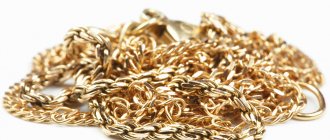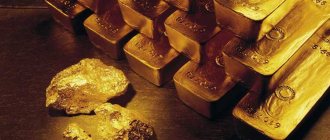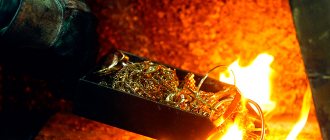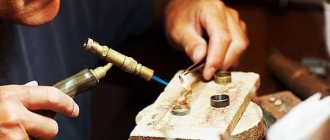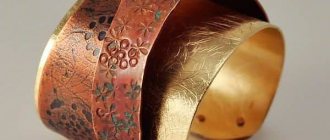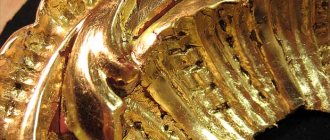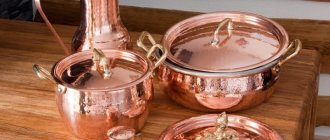Distinguishing gold from fake gold at home is not as difficult as it might seem at first. Everyone knows the “tooth test” method, but in reality it is of little use - after all, only pure gold is soft. And jewelry or products made of pure metal are almost impossible to find. Whether to check gold or not is a personal matter for everyone, but we still advise you to take a closer look at the jewelry to avoid unpleasant moments. A few simple methods that we will talk about today are worth adopting - because you never know where new knowledge will come in handy.
Instructions
Probably everyone has such a drug as iodine at home. If not, then it can easily be purchased at a pharmacy, since it does not require a doctor's prescription and is cheap. In medicine, iodine is considered an antiseptic. However, it is also used for other purposes. For example, a widely known method for testing gold is iodine, where it is used as an indicator to determine the authenticity of the metal. However, the drug will only help in recognizing gold. For other metal products it will not show the true result. So, having decided to try this method, you need to do the following.
- They take gold jewelry. Usually, doubts arise in samples 583 and 585, since their tint may be slightly reddish, which can raise doubts. But it may also be associated with the presence of an alloy in the metal composition.
- Then the product is lightly sanded on the inside. This is necessary for the reaction with iodine to occur. Most often, sandpaper is used for this, although you can use another abrasive.
- After soaking a cotton swab in iodine, apply it to the gold item in the place of wear. It doesn’t matter whether a small or large amount of iodine will participate in the reaction. Therefore, you need to try to apply only a small, unnoticeable spot. The reaction will not increase depending on the size of the abrasion area, but then you will have to spend more effort to wash it, and a trace of abrasion may remain.
- It remains to monitor the reaction. If a dark color stain appears, then the jewelry is genuine. It is precisely made of precious metal. But if the color remains the same, then the product is not gold, but bronze, copper or brass. The chemical reaction occurs because gold is able to react with halogens. And iodine is exactly that.
Chemical reactions of various gold samples to reagents
The table below shows the reactions of alloys of various samples to one or another reagent.
| Reagent/Sample | Chlorine gold | Acids | Potassium iodide |
| Below 375 | dirty dark green, gray-green spot | dirty dark green, gray-green spot | — |
| 375 sample | greenish-brown spot | — | — |
| 500 carat yellow gold | light brown spot | the drop remains transparent. Chestnut stain when using 585 sample reagent | — |
| 500 white gold | spots of different shades of brown | spots of different shades of brown | — |
| 585 yellow gold | transparent drop | bright spot | — |
| 585 white gold | golden stain | beige, golden or orange spot | — |
| 750 yellow gold | barely perceptible stain | barely perceptible stain | — |
| 750 white gold | light brown spot | light brown spot | — |
| 800 and 900 samples | — | — | dark red spot |
other methods
To check, you can use not only iodine, but also other substances, such as lapis pencil, vinegar, magnet. Your own hearing will also help. Many people know these methods. Therefore, if there is no iodine in the house, then it is quite possible to use them as an alternative method.
The lapis pencil contains silver nitrate, which is the active ingredient. The product is used in medicine for the purpose of cauterization. With its help, a test is done, the opposite of iodine. Gold is the only metal that will not react with a pencil. All others will change their color. However, if the product is of low quality, then the result is in question.
All you need to do is leave the decoration in the vinegar for only half a minute, during which you observe the reaction. There will be no reaction to gold. But other metals will begin to oxidize. But, if the sample turns out to be less than 750, then it is also difficult to judge the reliability, as in the previous case.
Attraction with a magnet will reveal the presence of a high iron content in the jewelry. Gold will not react to a magnet. However, at the same time, metals such as aluminum and copper are also not magnetic. Therefore, the experiment will only show the presence or absence of iron.
If a person has a good ear for music, he will be able to distinguish gold, since it is a sonorous metal. To do this, it should be thrown onto a smooth surface. Vibration should be heard, like crystal. Other metals, when hitting the surface, emit a heavy sound that is somewhat harsh on the ear. But, of course, this method cannot be called simple for the average person.
Safety precautions when working with chemicals
Chemical reagents are quite aggressive substances, so when working with them you must adhere to certain safety rules. This is especially true for the use of acids.
You need to lay a thick fabric on the surface where the testing procedure will take place. Hands are protected with gloves, clothing with an apron. Acids are diluted in a special container, added in a thin stream to distilled water. The liquid may become hot. Before using the composition on gold, it must be cooled.
Method of purification from iodine
Having completed the iodine test, another question may then arise on how to get rid of a stain on a gold item. After all, iodine, as we found out, leaves dark spots. However, you should not worry about this, since in this case special work will not be required. But you can be sure that the jewelry is actually gold.
Over time, the stain will disappear on its own. But if it is important to erase it urgently, then you can use one of the following cleaning methods after checking the gold. Solutions using soap or powder will be useless in this case, since the substance is resistant to them. The following will help.
- Hyposulfite can act as a cleaner. It is used to develop photos in the old way. Prepare the liquid as follows: take one tbsp. a spoonful of fixative and dilute it in a glass of water at room temperature. The gold item is kept in this solution for thirty minutes, and then washed under waste water and dried.
- Ammonia will also help. But before using it, it is worth considering that it will not always have the desired effect. In addition, the smell will take a long time to dissipate, within 3 days.
- You can also use the oldest method, which was known to our grandparents. To do this, take 70 g of soda, 80 g of lime and 20 g of salt. All components are mixed and dissolved in one liter of water, where the gold product is then placed for an hour and a half.
It is also worth remembering that testing gold for authenticity using iodine is only suitable when it is made of solid metal. If the product is gold-plated, the method will also indicate authenticity only if the corresponding layer is not erased. In addition, this can ruin the decoration. Therefore, it is better not to risk it and take it to the master.
Cleaning can be done at a jeweler as well as inspection. Naturally, they do all this at home for free. However, the result may be unreliable, and during the procedures there is a risk of damage to the jewelry. On the other hand, by contacting a jeweler, you can not only confirm the authenticity of the product, but also find out the sample of the existing alloy. A specialist will determine a reliable result in just a few minutes. Once upon a time, this required making cuts or cuts on the inside. However, today the inspection is carried out without compromising the integrity of the jewelry. The method consists in determining the density of gold and chemical. reactions. After checking, a specialist receives a document containing information about whether the jewelry contains gold or not.
Water test, Archimedes method
For the test you need: high-precision scales, thread, measuring cup, water (distilled will give a more accurate result), a table of the density of materials.
Density of precious metals:
| Density/p | 9 — 10 | 11 — 12 | 12 — 14 | 14 — 17 | 19,3 |
| Metal/sample | Silver | Gold/375, 500 | Gold/583, 585 | Gold/750 | Gold/999 |
To make gold jewelry, an alloy of gold and other metals is used. To indicate the percentage of gold, jewelry is marked with a hallmark. The higher the standard, the more expensive the jewelry. Also, the higher the percentage of gold content, the higher the density of the entire product.
Archimedes' method is based on these features. How to take measurements:
- Weigh the product (m).
- Find the volume - put a glass of water on the scale, reset the weight (the scale should read 0). We lower the product being tested into the water on a rope (without touching the walls and bottom), and record the readings (v).
- Carry out the calculation using the formula - p = m / v.
- The resulting density (p) is compared with the table (density of precious metals).
For clarity, check out the video on density measurement:
How to check authenticity in a store
People do not always have the opportunity to use home testing methods or take it to a jeweler. For example, you need to know exactly how to identify gold when purchasing it in a store. If a product is purchased on the territory of Russia, then it must have a sample and the letter of the person who puts the stamp on it. If this is not the case, then there is no need to talk about legal gold. Most likely it's costume jewelry. The quality of gold jewelry varies from country to country. Therefore, when it is bought in other countries, in addition to the sample, you must pay attention to other characteristics.
- The polish should be shiny.
- The coating and spraying are done evenly, and the color is the same.
- If the product contains a stone, it is firmly inserted.
- All units have their own tag made of white thick paper, in which there is a hole with a stretched thread. Here you can find information about the product: its weight, sample, manufacturer, name, legal address.
The presence of impurities can be determined visually by the color of the product. White color is formed with the help of silver and platinum, yellow - with silver and copper, red indicates that copper predominates in the alloy, green is obtained by combining silver, copper and cadmium, and a gray tint is acquired with the presence of steel. It is not recommended to purchase such a product over the Internet, as in this case there is a high risk of counterfeiting.
Visual inspection
Visual inspection boils down to checking the markings of the gold product. You need to find a sample and a distinctive sign of the manufacturer. The original product has all the details, the numbers are easy to read, and the stamping depth is the same. The size is barely readable.
At the top is a fake, at the bottom is a real gold ring.
Large numbers, the absence of a manufacturer's mark, and different depths of numbers should alert you. It is better to refuse such jewelry and not make a purchase.
Rules for wearing, caring for and storing gold jewelry
Gold jewelry should be worn carefully. Accessories designed to decorate the external image are recommended to be removed if there is likely exposure to foreign objects or kitchen fumes. A negative factor will be sudden temperature changes. In addition, the danger to jewelry is posed by:
- eau de toilette and deodorants;
- humid environment;
- contact with cutting, abrasive objects.
Places where jewelry is taken off:
- gyms;
- spa centers, beauty salons;
- baths and saunas, etc.
It is better to store your personal jewelry collection separately. When they come into contact, they leave scratches and become deformed. For this purpose, special velvet bags and cases have been created, similar to those found in jewelry stores. Jewelry accessories do not interact well in plastic, so it is better to avoid cases made of this material.
Excessive exposure to direct sunlight spoils jewelry. Therefore, they must be kept in a closed, dark space.
Application and technique of working with touchstone
In addition to chemical reagents, you can test a sample of a precious metal with a touchstone. The mineral of natural origin belongs to the group of silicon shale and contains about 8% carbon, which gives it a black color. There are also artificial touchstones.
The use of a tool begins with its preparation. The surface is wiped with castor oil, then rubs are applied - dense strips no more than 2-3 mm wide and up to 20 mm long. Vertical lines are applied nearby using standard needles that correspond to a particular sample. The rubs are moistened with reagents and the reaction is observed. A dark precipitate in comparison with the reagent indicates a low gold content in the alloy, a light one, on the contrary, indicates a higher one.
The advantages of testing jewelry on a touchstone are the preservation of its integrity, the testing of any alloys, and the simplicity of the procedure.
Buying reagents for gold will be a justifiable expense if they are used in a workshop or pawnshop. For home testing, less complex materials are suitable. In addition, the person conducting the testing must have certain skills, because reagents are expensive, and their wasteful use can hit your pocket.
